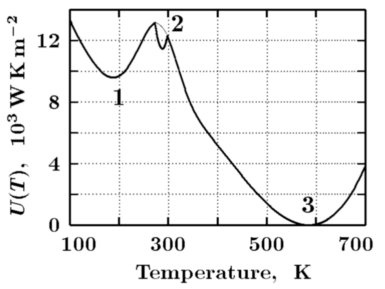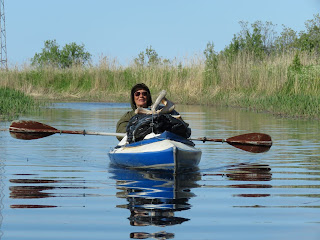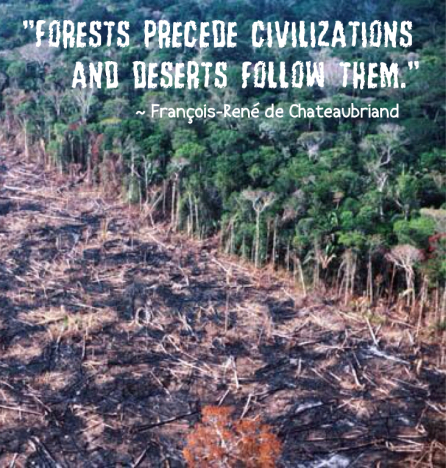via Cassandra Legacy |
Essay von Collapse of Industrial Civilization(2015):
Forests Precede Us, Deserts Follow
As Goes the Amazon, So Goes the World
Thought to be up to 100 million years old and home to more species than any other ecosystem on Earth, the Amazon rainforest is a magical place, but your average soft-bellied city dweller of industrial civilization would last no more than a week there, likely succumbing to yellow fever, malaria, flesh-eating parasites, venomous snakes, and an endless array of creepy-crawlies. Nearly one-third of the planet’s biodiversity is found in the Amazon, including ancient indigenous tribes, hundreds of animal species, 16,000 tree species, 2.5 million species of insects, and new discoveries happening all the time. With a treasure trove of medicinal plants, many of which have yet to be discovered, the Amazon is known to many as the world’s largest pharmacy. 70% of all drugs introduced in the U.S. in the last few decades were derived from nature, and 70% of plants identified as containing anti-cancer characteristics are found only in tropical rainforests.
The Amazon discharges one-quarter of the Earth’s freshwater and plays a critical role in the Earth’s carbon cycle and climate, absorbing 1.5 billion tons of carbon every year through photosynthesis. Additionally, the Amazon’s 400 billion trees are responsible for producing 20% of the Earth’s oxygen and generating the region’s heavy rains needed to irrigate crops, fill reservoirs, and generate hydropower. A single large rainforest tree is the equivalent of a standing lake releasing up to 317 quarts (300 liters) of water each day through evapotranspiration (evaporation and plant transpiration). The importance of the Amazon rainforest in regulating not only South America’s climate but also that of the entire world cannot be overestimated. Like the Earth’s cryosphere, the Amazon and other rainforests are essential geographic features of the planet that help regulate the climate and provide habitat for unique wildlife. As with the melting polar regions, the loss of the Amazon to capitalist “resource development” will prove to be a self-destructive act for all of mankind.
In 2006, two Russian scientists, Victor Gorshkov and Anastassia Makarieva, used basic physics to theorize that condensation from forests, not temperature gradients, is what creates the low atmospheric pressure over land masses necessary for pulling moist air currents from the coasts to the continental interiors. Forests drive the water cycle on land. After two years and major pushback from the established meteorological community, their paper was finally published in the journal Atmospheric Chemistry and Physics and to this day has withstood refutation.
Gorshkov and Makarieva argue that meteorologists have long-missed an important driver of winds: condensation, and most importantly condensation caused by the major evaporation that occurs over forests. While scientists have long noted that deforestation also brings a drop in precipitation, no one could adequately explain the mechanism behind this. But Gorshkov and Makarieva argue that forests drive winds through “persistent condensation,” bringing in rain from the oceans. Put simply: no forests, no rain…
“During condensation water vapor disappears from the gas phase. Air pressure depends on the number of air molecules and is reduced by condensation. Areas with persistent condensation become zones of low pressure that suck in the air from the surrounding regions. Forests ensure both a store and a flux of moisture on land and thus create such persistent low pressure zones on land. This causes moist winds to blow from the ocean to land,” they explain.
Put another way, regions with lots of rainfall “set up a positive feedback in which they bring in moisture from elsewhere,” according to Sheil, who adds that, “Forests maintain the highest evaporation of moisture of any land cover.”…
…if the biotic pump turns out to be true, it would not change the fact that the climate is changing and herculean efforts are needed to mitigate both the causes and the impacts, whether that focuses on greenhouses gas emissions, forests, or, as it happens, both, since forests ability to store carbon is just one of the many services they provide. – Link
A more in-depth explanation of the biotic pump theory can be found in these two videos here and here.
The biotic pump hypothesis explains what is behind the so-called “flying clouds of the Amazon” which carry moisture inland from the Atlantic ocean until they hit the Andes mountains and turn southward, dumping rain onto central and southern Brazil. Antonion Nobre, Brazil’s top climate scientist, is a proponent of the theory that forests function as biotic pumps for atmospheric moisture.
…As long ago as 2009, Antonio Nobre, one of Brazil’s leading climate scientists, warned that, without the ‘flying rivers’, the area that produces 70% of South America’s GNP would be desert.
In an interview with the journal Valor Economica, he said: “Destroying the Amazon to advance the agricultural frontier is like shooting yourself in the foot. The Amazon is a gigantic hydrological pump that brings the humidity of the Atlantic Ocean into the continent and guarantees the irrigation of the region.”
“Of course, we need agriculture”, he said. “But without trees there would be no water, and without water there is no food.
“A tonne of soy takes several tonnes of water to produce. When we export soy we are exporting fresh water to countries that don’t have this rain and can’t produce. It is the same with cotton, with ethanol. Water is the main agricultural input. If it weren’t, the Sahara would be green, because it has extremely fertile soil.”
Like other climate scientists, Nobre thinks the role of the Amazon rainforest in producing rain has been underestimated. In a single day, the Amazon region evaporates 20 billion tonnes of vapour – more than the 17 million tonnes of water that the Amazon river discharges each day into the Atlantic. – Link
In 1980, just 3% of the Amazon rainforest had been cut down, but today the total loss has grown to about 25%, and in the last five months of 2014 the assault on the Amazon has intensified with October registering a staggering increase of 467% in deforestation. Although agriculture and illegal logging constitute the majority of cleared land, a growing percentage over the last 13 years has been for gold mining, a process that is particularly damaging to the environment due to the toxic brew of chemicals left behind. The double whammy of deforestation and anthropogenic global warming continues to weaken the Amazon. Remember that the Amazon suffered two 100-year droughts within 5 years in 2005 and 2010 and failed to recover since then. Other studies have confirmed that the Amazon appears to becoming more unstable in response to the large-scale environmental impact of rising CO2 and the cumulative effects of land degradation by humans. A study that came out just last month indicates a tipping point of 30-50% deforestation of rainforests in the Amazon and Central Africa which could lead to global effects.
…“What this study shows is that there are additional, independent effects of deforestation on climate.”
Lawrence’s report is a peer-reviewed summary of existing research, and she found that deforestation, even at small, localized levels, can change the climate. “Farmers in one place are connected to farmers in another. Countries are connected to each other,” Lawrence said. “We don’t want to wait until the climate system has shifted so we can measure it on the ground.”
She said there is a possible “tipping point” of 30 to 50 percent deforestation for the Amazon and Central Africa. Deforestation beyond that could invite disaster.
“Tropical deforestation on many scales influences local, regional and even global climate. Deforestation-driven changes to water availability and climate variability could have strong implications for agricultural production systems and food security in some regions,” the report says… – Link
If we add up the harmful effects of climate change and deforestation to the Amazon, then the tipping point may have already been breached. According to the Global Risks 2015 report by the World Economic Forum (WEF), water has for the first time displaced all other concerns to become the number one threat:
“Droughts, floods, glacial melt, unpredictable precipitation, runoff, groundwater supplies and water quality will all reflect an increasing instability as long-standing rainfall patterns change and weather extremes increase,” said Ganter.
The interconnecting risks regarding water, food, energy and climate change will be one of the overarching megatrends to shape the world in 2030, according to Ganter. – Link
São Paulo, Brazil: Repeating the Mistakes of the Mayans
 A wall mural in São Paulo painted by Brazilian artists Mundano and Fel depicting a boat on a cracked riverbed
A wall mural in São Paulo painted by Brazilian artists Mundano and Fel depicting a boat on a cracked riverbed
São Paulo, a megacity of 20 million people in southeastern Brazil, is suffering its worst drought in 84 years since the summer rains failed to materialize a year ago. Only recently did water officials finally admit how serious the crisis was and that they had covertly rationed water by manipulating flow pressure in various parts of the city under the guise of “maintenance work”. Cantareira, the city’s largest water reservoir, is currently down to just 5.4% of its capacity and officials have implemented plans for pumping a third dead volume that represents the “rock bottom” of the reservoir. And this crisis isn’t just confined to São Paulo. Ninety-three other Brazilian cities affecting 3.9 million people are rationing water due to the lack of rain.
As of 1-22-2015:
Without water to run their hydroelectric power plants which provide 80-90% of the country’s electricity, Brazil has been forced to turn to more expensive and dirtier thermal plants burning natural gas, coal, diesel fuel and biomass. In turn, electricity rates have jumped 60% and Brazil’s CO2 emissions will undoubtedly increase. The rains may come again sporadically but I think the Brazilians have permanently broken the region’s biotic pump. What’s next for the wealthiest city in Latin America? Water wars will likely erupt for the last drop of moisture from a once-magnificent rainforest mowed down for hamburger-cattle, soybeans, and short-term profits.
Keeping the lights on and maintaining this current way of life is becoming increasingly tenuous as capitalist carbon man eats away at the last vestiges of a dying biosphere. Modern-day Brazil and the entire industrialized world are repeating the same mistake made by past civilizations such as the Mayans who cleared their forests for agriculture and development:
…In the first study, published Tuesday in the Proceedings of the National Academy of Sciences, researchers from Arizona State University analyzed archaeological data from across the Yucatan to reach a better understanding of the environmental conditions when the area was abandoned. Around this time, they found, severe reductions in rainfall were coupled with a rapid rate of deforestation, as the Mayans burned and chopped down more and more forest to clear land for agriculture. Interestingly, they also required massive amounts of wood to fuel the fires that cooked the lime plaster for their elaborate constructions—experts estimate it would have taken 20 trees to produce a single square meter of cityscape…
…Because cleared land absorbs less solar radiation, less water evaporates from its surface, making clouds and rainfall more scarce. As a result, the rapid deforestation exacerbated an already severe drought—in the simulation, deforestation reduced precipitation by five to 15 percent and was responsible for 60 percent of the total drying that occurred over the course of a century as the Mayan civilization collapsed. The lack of forest cover also contributed to erosion and soil depletion…
…The collapse is especially intriguing because it seemingly occurred at “a time in which developed a sophisticated understanding of their environment, built and sustained intensive production and water systems and withstood at least two long-term episodes of aridity,” says B.L. Turner, the lead author of the ASU study. In other words, the Maya were no fools. They knew their environment and how to survive within it—and still they continued deforesting at a rapid pace, until the local environment was unable to sustain their society.
One of the lessons of these complementary studies, says climate modeler Robert Oglesby of the University of Nebraska, who worked on the second paper, is that our reshaping of the environment can often have unintended consequences—and we may not have any idea of what they are until it’s too late… – Link
One could safely say all human endeavor is at the mercy of the natural world and the vagaries of the weather. The ebb and flow of the mighty Roman Empire, along with its downfall, aligned with shifts in the climate, according to tree ring research:
…When [lead researcher] Büntgen showed the data to historians and archaeologists, they pointed out remarkable consistencies with what we know of past societies. At times of social stability and prosperity, like the rise of the Roman Empire between 300 B.C.E. and 200 C.E., Europe experienced warm, wet summers ideal for agriculture. Similar conditions accompanied the peak years of medieval Europe between 1000 C.E. and 1200 C.E.
The study also showed that climate and catastrophe often line up. In the 3rd century C.E., for example, extended droughts matched the timing of barbarian invasions and political turmoil. Around 1300 C.E., on the other hand, a cold snap combined with wetter summers coincides with widespread famines and plague that wiped out nearly half of Europe’s population by 1347… – Link
Believing that somehow things are different this time around and that our technological prowess will save us, few today pay much attention to the history of man’s folly and the overreach of past civilizations. The brutal reality is that nothing has changed since then except for the epic degree of capitalist carbon man’s hubris and the scale of his overshoot which has now reached global proportions, guaranteeing that no one will be spared, neither rich nor poor, wretched nor innocent. Meanwhile, our fearless leaders took a page out of The Onion the other day and got together to agree that “climate change is real and not a hoax” while inserting the caveat that humans are still not the cause. Did that really just happen?…Don’t let this surreal world get you down. We’re simply spectators observing the tragicomedy of the human race.











